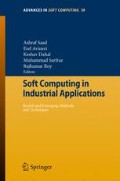Abstract
The work in this paper presents the use of population-based incremental learning (PBIL), one of the classic single-objective population-based optimisation methods, as a tool for multiobjective optimisation. The PBIL method with two different updating schemes of its probability vectors is presented. The performance of the two proposed multiobjective optimisers are measured and compared with four other established multiobjective evolutionary algorithms i.e. niched Pareto genetic algorithm, version 2 of non-dominated sorting genetic algorithm, version 2 of strength Pareto evolutionary algorithm, and Pareto archived evolution strategy. The optimisation methods are implemented to solve 8 bi-objective test problems where design variables are encoded as a binary string. The Pareto optimal solutions obtained from the various methods are compared and discussed. It can be concluded that, with the assigned test problems, the multiobjective PBIL methods are comparable to the previously developed algorithms in terms of convergence rate. The clear advantage in using PBILs is that they can provide considerably better population diversity.
Access this chapter
Tax calculation will be finalised at checkout
Purchases are for personal use only
Preview
Unable to display preview. Download preview PDF.
References
Baluja, S.: Population-based incremental learning: a method for integrating genetic search based function optimization and competitive learning. Technical Report CMU_CS_95_163, Carnegie Mellon University (1994)
Bureerat, S., Cooper, J.E.: Evolutionary methods for the optimisation of engineering systems. In: IEE Colloquium Optimisation in Control: Methods and Applications, IEE, London, Uk, pp. 1/1-1/10 (1998)
Bureerat, S., Limtragool, J.: Performance enhancement of evolutionary search for structural topology optimization. Finite Element in Analysis and Design 42, 547–566 (2006)
Coello, C.C., Romero, C.E.M.: Evolutionary algorithms and multiple objective optimization. In: Ehrgott, M., Gandibleux, X. (eds.) Multicriteria optimization, pp. 277–331 (2002)
Deb, K., Pratap, A., Meyarivan, T.: Constrained test problems for multi-objective evolutionary optimization. KanGAL Report No, 02, Kanpur Genetic Algorithms Laboraotry (KanGAL), Indian Institute of Technology, Kanpur, India (2000)
Deb, K., et al.: A fast and elitist multiobjective genetic algorithm: NSGAII. IEEE Trans. On Evolutionary Computation 6(2), 182–197 (2002)
Fonseca, C.M., Fleming, P.J.: Genetic algorithms for multiobjective optimization: formulation, discussion and generalization. In: Proc. of the 5th Inter. Conf. on Gas, pp. 416–423 (1993)
Fyfe, C.: Structured population-based incremental learning. Soft Computing 2(4), 91–198 (1999)
Grandhi, R.V., Bharatram, G.: Multiobjective optimization of large-scale structures. AIAA 31(7), 1329–1337 (1993)
Horn, J., Nafpliotis, N.: Multiobjective optimization using niched Pareto genetic algorithm. Tech. Report I11iGA1 Report 93005, UIUC (1993)
Horn, J., Nafpliotis, N., Goldberg, D.E.: A niched pareto genetic algorithm for multiobjective optimization. In: The 1st IEEE Conf. on Evolutionary Computation, pp. 82–87. IEEE Computer Society Press, Los Alamitos (1994)
Ivvan, S., et al.: Multiobjective shape optimization using estimation distribution algorithms and correlated information. In: Coello Coello, C.A., Hernández Aguirre, A., Zitzler, E. (eds.) EMO 2005. LNCS, vol. 3410, pp. 664–676. Springer, Heidelberg (2005)
Knowles, J.D., Corne, D.W.: Approximating the non-dominated front using the Pareto archive evolution strategy. Evolutionary Computation 8(2), 149–172 (2000)
Kunakote, T.: Topology optimization using evolutionary algorithms: comparison of the evolutionary methods and checkerboard suppression technique. Master thesis, Khon Kaen University (2004)
Messac, A., Ismail-Yahaya, A., Mattson, C.A.: The normalized normal constraint method for generating the Pareto frontier. Structural and Multidisciplinary Optimization 25(2), 86–98 (2003)
Schaffer, J.D.: Multiobjective optimization with vector evaluated genetic algorithms. In: GAs and their Application: Proc. of 1st Inter Conf. on Gas, pp. 93–100 (1985)
Sebag, M., Ducoulombier, A.: Extending population-based incremental learning to continuous search spaces. In: Eiben, A.E., et al. (eds.) Parallel Problem Solving from Nature - PPSN V. LNCS, vol. 1498, p. 418. Springer, Heidelberg (1998)
Srinivas, N., Deb, K.: Multiobjective optimization using non-dominated genetic algorithms. Evolutionary Computation 2(3), 221–248 (1994)
Yuan, B., Gallagher, M.: Playing in continuous spaces: some analysis and extension of population-based incremental learning. In: Proceedings of the 2003 IEEE Congress on Evolutionary Computation, Canberra, Australia, pp. 443–450. IEEE Computer Society Press, Los Alamitos (2003)
Zitzler, E., Deb, K., Thiele, L.: Comparison of multiobjective evolutionary algorithms: empirical results. Evolutionary Computation 8(2), 173–195 (2000)
Zitzler, E., Laumanns, M., Thiele, L.: SPEA2: improving the strength Pareto evolutionary algorithm for multiobjective optimization. In: Evolutionary Methods for Design, Optimization and Control, Barcelona, Spain (2002)
Zitzler, E., et al.: Performance assessment of multiobjective optimizers: an analysis and review. IEEE Trans. on Evolutionary Computation 7(2), 117–132 (2003)
Author information
Authors and Affiliations
Editor information
Rights and permissions
Copyright information
© 2007 Springer-Verlag Berlin Heidelberg
About this paper
Cite this paper
Bureerat, S., Sriworamas, K. (2007). Population-Based Incremental Learning for Multiobjective Optimisation. In: Saad, A., Dahal, K., Sarfraz, M., Roy, R. (eds) Soft Computing in Industrial Applications. Advances in Soft Computing, vol 39. Springer, Berlin, Heidelberg. https://doi.org/10.1007/978-3-540-70706-6_21
Download citation
DOI: https://doi.org/10.1007/978-3-540-70706-6_21
Publisher Name: Springer, Berlin, Heidelberg
Print ISBN: 978-3-540-70704-2
Online ISBN: 978-3-540-70706-6
eBook Packages: EngineeringEngineering (R0)

